|
"Probably the most
prominent Egyptian knapped chert object is the "Gerzean" or "Ripple
flaked" knife."---------2009,
Marquardt Lund, "Egyptian Flint Work Part III Fishtail Knives,
Rhomboid Knives, Gerzean Knives and Flint Figurines," Chips,
Vol. 21, #3, p. 9.
"In tomb 1226 (at Helwan
excavations, 15 miles south of Cairo)
were two flint knives of a different design. These knives, each about 50
centimeters (19 5/8 inches)
long, are the largest ever discovered in Egypt."--------1969,
Zaki Y. Saad,
"The Excavations At Helwan," p. 43.
"Egypt's Predynastic Period belongs to
prehistory, or the story of human cultures before written records began."--------2009, Abeer el-Shahawy,
" Egyptian Museum In Cairo: A Walk Through The Alleys Of Ancient Egypt,
p. 11.
"In the
Naqada II phase (of the Predynastic
Period), flint was the most important material in use for making
tools such as knives, chisels, punches and scrapers."------2009,
Abeer el-Shahawy," Egyptian Museum In Cairo: A Walk Through The Alleys
Of Ancient Egypt, p. 11.
"Egyptian Predynastic flint knives belong in museums to the
most admired, and in books to the most often shown stone tools of
prehistory."---------1984,
Peter Kelterborn, "Towards Replicating Egyptian Predynastic Flint
Knives," Journal Of Archaeological Science 1984, 11, p. 433.
"The ripple
flaked knives of the Late Predynastic Period are among the finest flint
knives from anywhere in the world."---------internet
2012, British Museum.org.

"FANCY" FLINT KNIVES
LATE PREDYNASTIC TO
PROTODYNASTIC PERIODS
EGYPT
Ancient Egypt is most famous for its
spectacular monuments, tombs, and art from the Dynastic Periods. But in
comparison, the Predynastic Period was a Neolithic society represented
by people who were still
using stone tools. The Predynastic period is more famous for such things as decorated ceramics,
jewelry, carved figurines, paint palettes, stone maces and
"fancy knives." Stone tools usually don't impress the average
museum-goer as much as the more artistic items. But the flint knives
from the Predynastic Period may be one exception. They represent some of the best
flint-work that has ever been done by skilled craftsmen anywhere in the
world. |
|
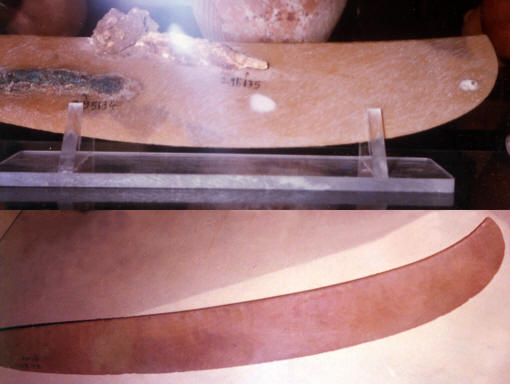
PHOTO BY DAN THEUS, CAIRO MUSEUM,
COMPUTER ALTERED IMAGE.
GERZEAN
KNIVES
PREDYNASTIC PERIOD
EGYPT
These two Gerzean knives are on display in the Cairo Museum.
They are displayed showing the sides that have been ground smooth.
The opposite sides would have a parallel pressure flaked surface.
The knife in the upper picture appears to have organic materials
encrusted on its surface. The lower knife seems to be fairly long.
Both of these knives were probably collected from Predynastic tombs. |
|
|
Flinders Petrie is considered the father of modern
archaeology in Egypt. He probably dug as many of more Predynastic
knives than anyone. In 1928 at Naqada, just north of Luxor, he
discovered and excavated a huge cemetery containing over 2,100 simple
rectangular tombs. It was from this excavation that Petrie discovered
and named the Predynastic Period. |
|
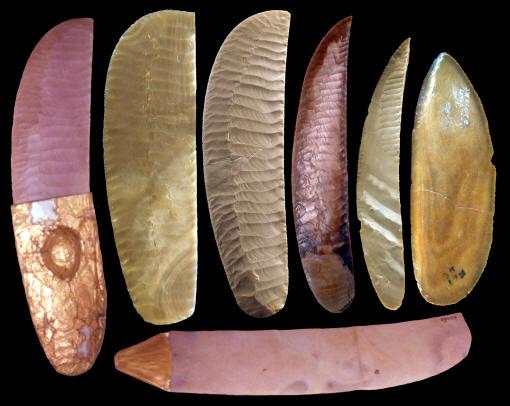
CLICK ON PICTURE FOR LARGER IMAGE
GERZEAN
KNIVES
PREDYNASTIC PERIOD
EGYPT
This picture shows several different examples of Gerzean knives.
They all have the same basic long curving blade edge and a straight
to slightly concave back edge. They illustrate two main differences
in the manufacturing process. Four of the knives were made from
bifacially percussion flaked preforms. The other three knives (top
row three from the right) were made from large flakes. Two of these
flake Gerzean knives have parallel flaking on one side that
obviously enhances their eye appeal. It's interesting to note that
just the large flakes alone, without the added decorative pressure
flaking would have been just as functional for cutting purposes.
These types of Gerzean knives were easier to make because they
skipped the time consuming process of bifacially percussion flaking
a preform and grinding both sides smooth prior to applying the
parallel "ripple" flaking on one side. These may have been the cheaper "poor man's" Gerzean knives.
The other four Gerzean knives in this picture represent the best of
the "classic" ripple flaked Gerzean knives. They were all made from
bifacially percussion flaked preforms that were ground smooth prior
to applying the decorative parallel "ripple" style pressure flakes
on one side. Two of these knives also have gold foil wrapped
handles. These are the types of knives that would have been owned by
wealthy high status individuals. |
|
|
An estimated date for the Predynastic Period is between 5000 B.C.
and 3100 B.C. This period is divided into different sub-periods
beginning with Badarian (5000 B.C.), then Amratian also referred to as
Naqada I (4000 B.C.), then Early Gerzean also referred to as Naqada II
(3500 B.C.) then Late Gerzean also referred to as Naqada II (3300 B.C.)
The Predynastic Period ended with the political unification of the
region under the first kings of the First Dynasty about 3100 B.C. |
|
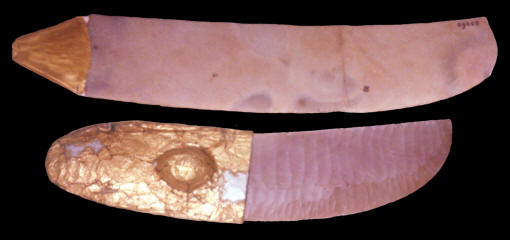
GERZEAN
KNIVES WITH GILDED HANDLES
PREDYNASTIC PERIOD
EGYPT
Both of these Gerzean knives are on
display in the Cairo Museum. They are displayed with one showing the
smoothly ground side and the other showing the parallel pressure flaked
side. At least some Gerzean knives
were apparently
high status objects because they were so well made and, like these two
examples, some are richly decorated with gold foil. They have also been
found with carved ivory handles. Motifs on the various types of handles include goddesses,
heroes and a scene of a boat battle.
The lower knife is described as a knife with a flint blade and a
handle that is covered with gold leaf. The handle is decorated with
floral and stylized animal designs. This knife is of unknown provenance
but dates to the Naqada II phase within the Predynastic Period to about
3500 B.C. |
|
|
The people who lived during the Predynastic Period were
using stone tools. Copper began to be used late in the period in the form of
various types of cast tools and weapons. The use of copper rapidly begins to replace
stone tools at the end of the Predynastic Period and beginning with the
First Dynastic kings. The only metals used during the Archaic Dynasties
before the Old Kingdom Dynasty is copper, gold and silver. |
|
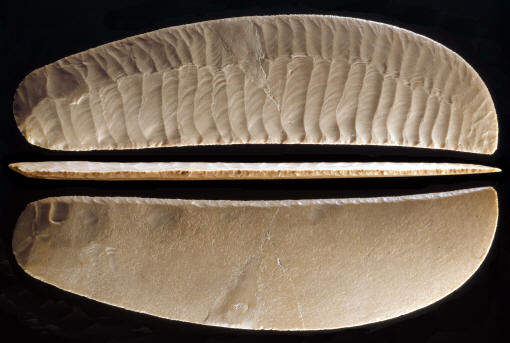
CLICK ON PICTURE FOR LARGER IMAGE
GERZEAN KNIFE
PREDYNASTIC PERIOD
EGYPT
This picture shows three views of a
very well made "classic" example of a Gerzean ripple flaked knife. Most
of these knives have been reported from Predynastic tombs. They were
made by specialized craftsmen. The manufacturing process begins with a
preform that was
percussion flaked into the desired shape. Then both sides were ground
and polished smooth. The smooth surface of one side only was then
uniformly removed with parallel pressure flaking. A completed Gerzean
knife has a smooth ground surface on one side and a parallel pressure
flaked surface on the other. This
Gerzean knives measures 8 ¼ inches (22cm) long and 2 3/16 inches (5.5cm)
wide. |
|
|
Flinders Petrie described what he called "fancy flint knives" from
his excavations of Predynastic tombs. Predynastic knives are represented
in many museum collections around the world. But a good number of them
do not have a provenance. Even some of the examples on display in the
Cairo museum will list them as "unknown provenance." But enough of
these "fancy knives" have been found in tombs to identify their main
purpose as funerary offerings or possibly as ritual tools that were left
behind. Zaki Y. Saad, writes about the contents from one of the
tombs at Helwan; "In it (a magazine storage
room connected to a tomb) we found
layers of ribs and other bones of sacrificial oxen. Below the first
layer of bones we found a nicely shaped flint knife 35 centimeters (13
3/4 inches) long." |
|
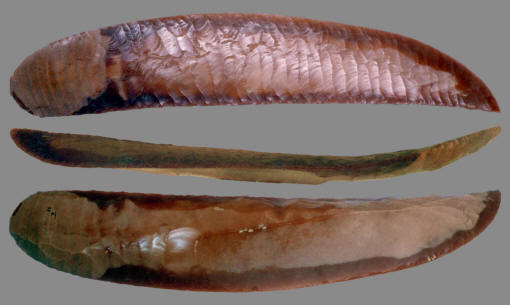
CLICK ON PICTURE FOR LARGER IMAGE
GERZEAN FLAKE KNIFE
PREDYNASTIC PERIOD
EGYPT
This Gerzean knife was made on a long narrow and curved flake.
Unlike the "classic" Gerzean knives that begin their
manufacturing process with a percussion
flaked preform that's been ground smooth on both sides, these types of Gerzean knives were made on edge
trimmed flakes. The preform for this knife was made by trimming the
edge to the desired shape by pressure flaking. The decorative
parallel pressure flaking was applied to the smooth surface of the
flake. No grinding was necessary. Most of the opposite
side is the original flake surface. |
|
|
The most skillfully flaked stone artifacts ever made during the
late Stone Age anywhere in the world are the best of the best examples of
the ripple flaked Gerzean Knives. They represent a high point in
flintknapping technology and are characteristic of the Predynastic
period of ancient Egypt. |
|
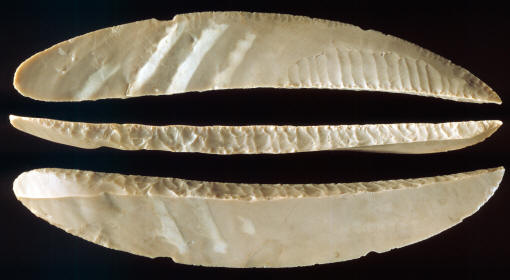
CLICK ON PICTURE FOR LARGER IMAGE
GERZEAN FLAKE KNIFE
PREDYNASTIC PERIOD
EGYPT
This picture shows three
views of a Predynastic knife that is similar to a Gerzean knife in
several ways except for the fact that is was made on a flake with no
grinding. It was pressure trimmed to a typical Gerzean shaped outline by
straightening one of the blade edges. The few parallel pressure flakes
removed on one side and the micro edge serrations are typical Gerzean
manufacturing traits. Gerzean flake knives like this example were a
lower and cheaper grade of knife that could have been made very quickly. This
knife is made of good quality light tan colored chert and it measures 7
inches (17.8 cm) long and 1 1/4 inches (3.2 cm) wide. |
|
|
The best Gerzean knives were more difficult and time consuming to make
compared to other Predynastic knives. They were made from good quality
stone. The preform for a knife was first percussion flaked into the
desired shape. Then both sides were ground and polished smooth. The
smooth surface of one side only was then uniformly removed with parallel
pressure flaking. A completed Gerzean knife has a smooth ground surface
on one side and a parallel pressure flaked surface on the other. This
unique style is only found in Egypt but a similar manufacturing
technique was also used on
some Neolithic daggers from northern Europe. |
|
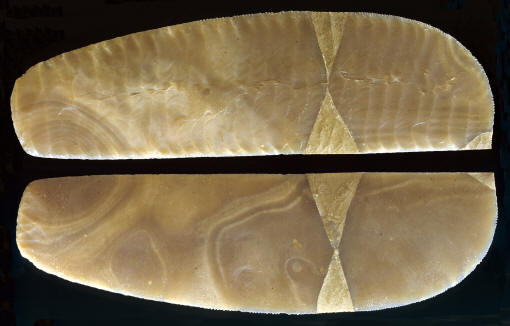
CLICK ON PICTURE FOR LARGER IMAGE
GERZEAN KNIFE
PREDYNASTIC PERIOD
EGYPT
This picture shows two views of a
"classic" Predynastic Gerzean knife. Like many other examples, this
knife was broken from a strike in the center of the blade that might
suggest that it was ritually "killed." This knife would have been made
from a percussion flaked preform that was ground smooth on both faces.
Parallel pressure flakes were applied to one side and the blade edge was
finely serrated. This Gerzean knife was made from a fine grade of
slightly translucent chert and it measures 8 7/8 inches (22.5 cm) long
and 2 9/16 inches (6.5 cm) wide. |
|
|
Gerzean knives have been replicated by modern flintknappers. The best
study was done by Peter Kelterborn of Switzerland and published in the
"Journal of Archaeological Science in 1984. He was able to make copies
of the best examples out of glass and flint. He described the
manufacturing sequence as consisting of six basic stages that involved
percussion flaking, grinding, large pressure flaking and micro-flaking. |
|
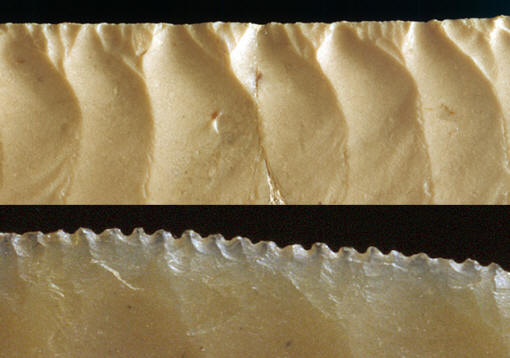
CLICK ON PICTURE FOR LARGER IMAGE
RIPPLE FLAKING AND SERRATED EDGE
GERZEAN KNIVES
PREDYNASTIC PERIOD
EGYPT
These magnified views from
two different Gerzean knives show classic flake removal patterns that
can be observed on the best examples of Gerzean knives. The upper
picture shows some very well done parallel pressure flaking on the back
edge of one knife. This type of flaking decoration is one factor that has made
Gerzean knives so famous. The area on the edge between the flakes are
trimmed by pressure into small delta shapes. The lower picture shows
some very well done serrations along the cutting edge of another knife. |
|
|
Some
knives might be described as Gerzean-like but they were not made in
exactly the same way as "classic" Gerzean knives. Two of the examples in
this report were made from long flakes. The ripple flaking was applied
to the surface of the flake rather than on a ground surface. Evidently, a
flat smooth surface, no matter how it was produced, was acceptable for
the production of Gerzean knives of lesser quality. |
|
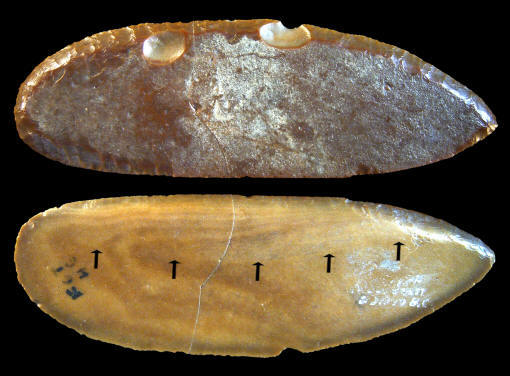
CLICK ON PICTURE FOR LARGER IMAGE
GERZEAN FLAKE KNIFE
PREDYNASTIC PERIOD
EGYPT
This is another of what
appears to be a Gerzean-like knife. It was not made from a bifacially
percussion flaked preform but instead it was made on a large flake. This
knife was shaped into the form of a Gerzean knife by grinding and by
pressure trimming the edge. The arrows point to the area were it was
ground into shape. The opposite side still retains most of the original
outer cortex of the stone. There is some short parallel pressure flaking along the edge of the base. This knife measures 6 5/16 inches (16
cm) long and 2 1/16 inches (5.2 cm) wide. |
|
|
Gerzean ripple flaked knives
were apparently
high status objects. In a few instances they have survived with richly
decorated gold foil and carved ivory handles. Motifs include goddesses,
heroes and a scene of a boat battle. |
|
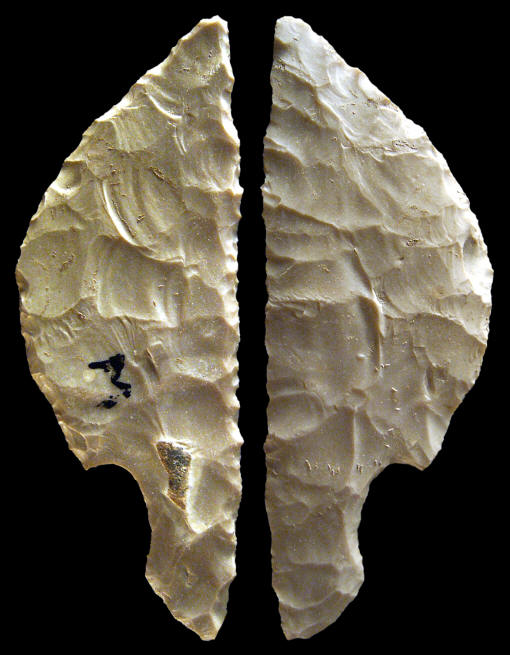
CLICK ON PICTURE FOR LARGER IMAGE
PERCUSSION FLAKED KNIFE WITH
HANDLE
PREDYNASTIC PERIOD
EGYPT
This picture shows a
typical example of a percussion flaked knife from the Predynastic
Period. It's made in the "classic" style with a long curved blade edge
and a straight back edge. This knife also has a handle that is actually
more of a finger notch. Handle designs vary but on these smaller more
common knives they do seem to be functional rather than just decorative
like those on large tomb swords. This knife is made from a gray colored chert of good quality
and it measures 5 5/8 inches (14.3 cm) long and 2 inches (5.1 cm) wide. |
|
|
A fairly large number of ripple flaked Gerzean knives are broken.
Some were struck in the center of the blade or cleanly snapped into two
pieces. This may indicate a tradition of deliberate breaking, suggesting
that some of them were ritually "killed." Burning or braking
funerary artifacts was not an uncommon practice among Stone Age
cultures. |
|
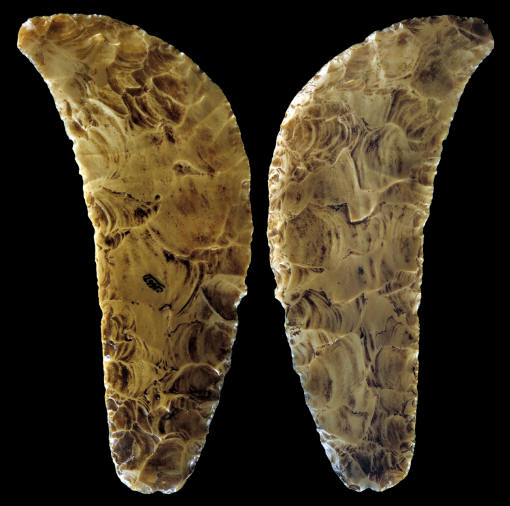
CLICK ON PICTURE FOR LARGER IMAGE
PERCUSSION FLAKED KNIFE WITHOUT
HANDLE
PREDYNASTIC PERIOD
EGYPT
This is a nice example of a
percussion flaked Predynastic knife. It has the typically wide sweeping
curved blade edge. These types of heavy duty knives were probably being
used for both utilitarian and for special ritual purposes. Animal
sacrifice would be one example of a ritual purpose. This knife measures
6 5/8 inches (16.8 cm) long and 2 1/4 inches (5.7 cm) wide. |
|
|
Most of the knives from the Predynastic Period were bifacially
flaked by percussion and never were ground or parallel pressure flaked
like Gerzean knives. They are categorized as flint knives with handles
and flint knives without handles. They all have a basic curved shape.
The outer curved edge represents the main cutting edge. The opposite
back
edge varies in shape from straight to deeply concave curvatures. |
|

PHOTO BY DAN THEUS, CAIRO MUSEUM,
COMPUTER ALTERED IMAGE.
PERCUSSION FLAKED KNIFE WITH
HANDLE
PROTODYNASTIC PERIOD
EGYPT
This large knife is on
display in the Cairo Museum. These types of knives have been found in
royal tombs that date to the first Dynasty, approximately 5,000 years
ago. Two large curved knives similar to this example but without handles
were reported from a tomb on
the early dynastic site of Helwan. They measure 19 5/8 inches (50 cm)
long and about 2 3/4 inches (7 cm) wide and they are reported to be "the longest
ever discovered in Egypt." |
|
|
Some percussion flaked knives exhibit heavy use wear. Flinders
Petrie describes some of the knives found at Abydos as "Many of the
specimens (flint knives
without handles) are
greatly changed in outline by wear." He also refers to a type of wear
pattern he called snubbing along the edge that he describes as being
"the result of scraping away from the person," when the flint is held in
the right hand. |
|

SCRAPER
MADE FROM BROKEN GERZEAN KNIFE
HIERAKONPOLIS SITE
PREDYNASTIC PERIOD
EGYPT
This picture shows both
sides of a discoidal shaped scraper that was made from a fragment of a broken
Gerzean knife. One side is beautifully ripple flaked and the other side
is ground smooth. This scraper measures 2 1/16 inches (5.3 cm) wide. |
|
|
Just as the Gerzean knives have been found in a wide range of
quality of manufacture the same can be said for the percussion flaked
knives. Some of the best examples rival their skill in manufacture to
any bifaces that have been found anywhere else in the world. Zaki Saad
reports one tomb at the early dynastic site of Helwan that contained two
flint knives that were about 19 5/8 inches (50 cm) long and about 2 3/4
inches (7 cm) wide. These knives are percussion flaked and have a deep
curve across their length and they do not have handles. Zaki Saad
reported them to be "the longest ever discovered in Egypt." A similar
knife with a handle design flaked onto its base is in the Royal Ontario
Museum. This knife is not as long but its handle was wrapped in gold.
The best examples of these large curved percussion flaked knives date to
the first Dynastic Period. |
|
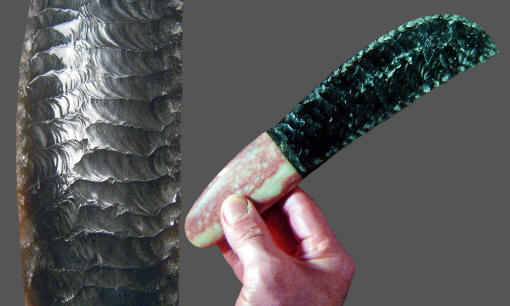
GERZEAN KNIFE
MADE BY STEVE ALLELY
This Gerzean knife was made
by Steve Allely. The knife blade is made of obsidian and the handle is
made of alabaster. Both sides of the knife was ground smooth then the
surface of one side was
uniformly removed with parallel pressure flaking.
This knife measures 9 3/8 inches (23.8 cm) long. |
|
|
Many golden ages have come and gone throughout Stone
Age history. It's during these short periods of time that flintknappers have
produced some of their best work. The "fancy flint knives" of the Predynastic Period
is only one example. Their best work has always been found in graves,
tombs or special cache offerings. If it were not for these unique time capsules
the modern world would never have seen any of these most exceptionally
crafted pieces. |
|
"REFERENCES"
1902, Petrie, W. M. Flinders, "Abydos,"
Part I, pp. 10-11.
1969, Saad, Zaki Y.,
"The Excavations At Helwan," pp. 30-31 & 43.
1984, Kelterborn, Peter, "Towards Replicating Egyptian Predynastic Flint
Knives," Journal Of Archaeological Science 1984, 11, p. 433.
1988, Hoffman, Michael Allen, "Prelude To Civilization: The
Predynastic Period In Egypt," The First Egyptians, pp. 33-58.
2009, Lund, Marquardt, "Egyptian Flint Work Part III Fishtail
Knives, Rhomboid Knives, Gerzean Knives and Flint Figurines," Chips,
Vol. 21, #3, p. 9.
2009, el-Shahawy, Abeer, " Egyptian Museum In Cairo: A Walk Through
The Alleys Of Ancient Egypt, p. 11 & 17.
From Personal Communications with Michael Allen Hoffman, PhD.
(deceased)
|
|
RECENT
LISTINGS HOME
ORDERING |